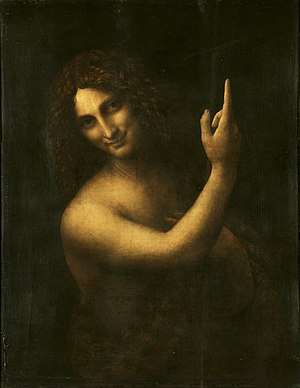Saint John the Baptist (Leonardo)
Saint John the Baptist is a High Renaissance oil painting on walnut wood by Leonardo da Vinci. Probably completed from 1513 to 1516, it is believed to be his final painting. The original size of the painting was 69 × 57 cm. It is now exhibited at the Musée du Louvre in Paris, France.
| Saint John the Baptist | |
|---|---|
 | |
| Artist | Leonardo da Vinci |
| Year | 1513–1516 (?) |
| Medium | Oil on walnut wood |
| Dimensions | 69 cm × 57 cm (27.16 in × 22.44 in) |
| Location | Louvre, Paris |
Subject matter
The work depicts John the Baptist in isolation. Through the use of chiaroscuro, the figure appears to emerge from the shadowy background. The saint is dressed in pelts, has long curly hair and is smiling in an enigmatic manner reminiscent of Leonardo's famous Mona Lisa. He holds a reed cross in his left hand while his right hand points up toward heaven like that of Saint Anne in Leonardo's Burlington House Cartoon. According to Frank Zöllner, Leonardo's use of sfumato "conveys the religious content of the picture," and that "the gentle shadows imbue the subject's skin tones with a very soft, delicate appearance, almost androgynous in its effect, which has led to this portrayal being interpreted as an expression of Leonardo's homoerotic leanings."[1]
Kenneth Clark claimed that for Leonardo, Saint John represented "the eternal question mark, the enigma of creation", and noted the sense of "uneasiness" that the painting imbues.[2] Barolsky adds that: "Describing Saint John emerging from the darkness in almost shockingly immediate relation to the beholder, Leonardo magnifies the very ambiguity between spirit and flesh. The grace of Leonardo's figure, which has a disturbingly erotic charge, nonetheless conveys a spiritual meaning to which Saint John refers when he speaks of the fullness of grace from God."[3]
Dating
The dating of Saint John the Baptist is disputed.[4] It was seen by Antonio de Beatis in Leonardo's workshop at Clos Lucé;[5] his diary entry giving a terminus ante quem of 17 October 1517.
Traditionally the painting has been considered the artist's last and dated to 1513–1516; Leonardo's sfumato technique here being considered to have reached its apogee.[4] Some experts, however, have compared the hand of Saint John to a similar work by a pupil in the Codex Atlanticus, dating the commencement of the picture to around 1509.[4] The pose is also similar to that of a sculpture of the same subject completed after 1510 for the Florence Baptistery by Giovanni Francesco Rustici.[6] Leonardo is thought to have given Rustici technical advice for his commission; it is possible that one artist could have influenced the other with the idea for the pose.[7]
Provenance
Saint John the Baptist was apparently part of the French king Francis I's collection at Fontainebleau in 1542. In 1625 Charles I of England received the painting from Louis XIII of France in return for a Titian Holy Family and Holbein's Portrait of Erasmus.[4] In 1649 Charles's collection was sold, whereupon the painting entered into the hands of the banker Eberhard Jabach.[4] After a spell in the possession of Cardinal Mazarin, in 1661 the work once again returned to the King of France – Louis XIV. Following the French Revolution the painting entered the collection at the Louvre where it remains to this day.[4]
Influence
Prior to this work, Saint John had traditionally been portrayed as a gaunt ascetic. Leonardo's innovative depiction proved influential upon Raphael's workshop; several portraits of Saint John painted around 1517–18 attributed to Raphael and Giulio Romano show a similarly youthful saint in isolation, with a strong contrast between the dark background and the illumination of the figure.[8]
Numerous copies and variations of Saint John the Baptist made by Leonardeschi exist.
 John the Baptist – Salaì
John the Baptist – Salaì Angelo Incarnato, drawing of Salaì, from a folio of Leonardo's, c. 1515
Angelo Incarnato, drawing of Salaì, from a folio of Leonardo's, c. 1515 Angel of Annunciation – Bernardino Luini
Angel of Annunciation – Bernardino Luini Saint John – Giampietrino
Saint John – Giampietrino
External links
- Interactive online application by the C2RMF for the exhibition "Leonardo da Vinci's Saint John the Baptist in Milan", organized by the Louvre Museum, Milan City Council and sponsored by Eni, featuring zoomable high resolution scientific imagery (color, IR, X-ray, UV etc.) and commentary on the painting. The viewer is based on IIPImage.
- Leonardo da Vinci: anatomical drawings from the Royal Library, Windsor Castle, exhibition catalog fully online as PDF from The Metropolitan Museum of Art, which contains material on Saint John the Baptist (see index)
- Lairweb.org.nz John the Baptist
References
- Zöllner, Frank (2000). Leonardo Da Vinci, 1452–1519. ISBN 9783822859797.
- Barolsky, Paul (1999). Leonardo Da Vinci, Selected Scholarship: Leonardo's projects, c. 1500–1519. p. 391. ISBN 9780815329350.
- Barolsky, Paul. Leonardo Da Vinci, Selected Scholarship: Leonardo's projects, c. 1500–1519. p. 394.
- Frank Zöllner. Leonardo da Vinci: The Complete Paintings. p. 248.
- Farago, Claire J. (1999). Biography and Early Art Criticism of Leonardo Da Vinci. p. 66. ISBN 9780815329336.
- Decker, Heinrich (1969) [1967]. The Renaissance in Italy: Architecture • Sculpture • Frescoes. New York: The Viking Press. p. 26.
- Wallace, Robert (1972) [1966]. The World of Leonardo: 1452–1519. New York: Time-Life Books. p. 147.
- Zöllner, Frank (2000). Leonardo Da Vinci, 1452–1519. p. 199. ISBN 9783822859797.